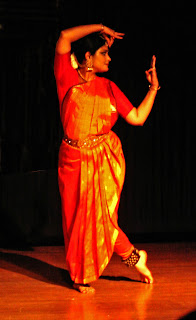Bhav ka Anubhav
Bhav ka anubhav
Geeta Chandran is a doyen of Bharatnatyam dance in India.
Bharatnatyam stands for ‘bhav’, ‘raag’, and ‘taal’, and Geeta personifies all three. She has
been awarded numerous national and international awards, including the
‘Padmashri’.
Geeta recently performed at
The Bhatkhande Music festival at Alliance Francoise Auditorium on the evening
of
December 5th.
The evening began with ‘Ganpati Vandana’ sung by
Sudha Raghuraman. The first piece was ‘Pushpanjali’, which was to worship and
sanctify the stage. This was followed by ‘Amba-Shambhavi’, which was an
invocation of ‘Maa Durga’. ‘Shakti’ is the epitome of beauty, kindness and
benevolence because she is the mother of the universe. On the other hand, she
vanquishes evil from the face of the earth. For that, she takes on an angry
incarnation. ‘Amba, ‘Shambhavi’, ‘Chandramouli’, ‘Uma’, ‘Parvati’, ‘Kali’,
‘Hemvati’, ‘Shiva’, ‘Katyayani’, ‘Navyauvani’, ‘Shubhkari’, ‘Lakshmi’,
‘Bhadrakali’, ‘Jwalamukhi’, ‘Vaishnavi’, ‘Chamunda’, ‘Bhagwati’, ‘Rajrajeshwari’
– this ‘stuti’ portrayed the various avatars of the goddess, sometimes
showering her love as a mother, at other times portraying the stateliness of
‘Rajrajeshwari’, and sometimes the anger of ‘Chamunda’. Geetachanged her facial expressions, the expressions
of her eyes and ‘bhangimas’ to represent the various aspects of each avatar.
Geeta pointed out that there has been a lot of give and take between
Hindustani and Carnatic music. Her upbringing in north India has made her
familiar with the north Indian poets. Her next composition was an ‘abhinaya’ on
the Meera bhajan ‘Sham mohe chakar rakho ji’. She said that this ‘bhajan’ had
the flavour of Meera’s ‘bhakti and ‘unmaad’. It is a plea to your Lord to keep
you as a servant and then the feeling of final union with him, which is
indescribable. Geeta moved
with that ecstasy in her dance. She said that dance transcends the barrier of
language. Whether it is the poetry of the Tamil scholars or the verses of Hindi
poets, the translation into the universal language of dance is an exhilarating
experience.
The next composition had its roots in Banaras, in
the ‘Panchakshar Mantra’, which embodies Lord Shiva. He is the Lord of
procreation and destruction. He is also the Lord of dance and is worshipped as
the ‘Nagendra-haraye’, ‘Trilochanaya’, ‘Maheshwaraya’, ‘Digambaraya’,
‘Nandeeshwaraya’, ‘Neelkanthaya’, ‘Jatadharaya’, ‘Gangadharaya’. He is known by
his various attributes. The magnificence of Lord Shiva was portrayed by Geeta in her stances and expressions. It
is customary to believe that the person impersonating the Lord comes to embody
Him. The sparkle in Geeta’s eyes
that evening truly did have a divine grace.
‘Padmajavali’ is a narrative of ‘bhav’. The next
piece was based on poetry by Surdas, ‘Suni sut kaho pyari’. Lord Krishna is
refusing to sleep and Maa Yashoda is desperately trying to put him to sleep by
telling him the story of ‘Ramayana’. Geeta chose
this composition for the performance because the audience and the stage were
small and that would make it a more intimate experience. The performance
involves ‘bhav nritya’ while sitting down and that would have lost its impact
in a larger space. The narrative covers the various aspects of Lord Rama’s life
from his birth in Ayodhya, ‘dhanush bhanjan’ in Janakpur, his vivah to Sita,
exile to the forest, Bharat milap, the killing of the kanak mrig and the
kidnapping of Sita. It is at this moment that the almost asleep Krishna leaps
up and asks Lakshman to hand him his bow and arrow. He exhibits the ‘aavesh’ of
Lord Rama and Maa Yashoda is left spellbound. She cuddles her son and puts him
to sleep. ‘Bhav Nritya’ is very difficult to perform because it requires just
the right kind of emotions and expressions, butGeeta did it flawlessly.
The final piece was an ode to Lord Krishna, he who
is ‘Radharamana’, ‘Vanamali’, ‘Vasudev’, ‘Jagmohan’, ‘Shashivadana’ and
‘Sarsijnayana’. Geeta said
that the mood of the performance was a continuation of the previous day’s dance
in ‘Vrindavan’, where she danced in a temple, only for the Lord, and her last
performance of the evening was her final offering to her Lord.





Comments
Post a Comment